How to sheathe a gas stove: options and instructions for decorating the wall near the gas stove + security measures
Having started repairs in the kitchen, we often think about how to sheathe a gas stove so that the coating lasts for many years and does not lose its appearance after the first cleaning.
You must admit that finishing the working wall in the kitchen is not an easy task and requires observing a number of conditions. After all, cooking is a process that has a strong effect on the exterior of the kitchen: there are splashes of fat, and water, and steam. Over time, all this may not have the best effect on the outer lining.
Next, we will tell you what materials can be used for wall cladding behind a gas stove. And we will understand the intricacies of their installation. Here are step-by-step instructions, equipped with visual photos and useful videos.
The content of the article:
Apron materials
Before materials for facing kitchen walls quite high requirements are put forward. After all, housewives spend a lot of time in the kitchen preparing food. Therefore, it is very important that the environment is not only pleasing to the eye, but also practical.
So, materials for protecting walls from a gas stove should have the following characteristics:
- Moisture resistance. Everyone knows that the humidity in the kitchen is always at an elevated level - steam when cooking, splashes of hot and cold water. All this can adversely affect finishing materials with low moisture resistance.
- Heat resistance. Near the gas stove, the walls always heat up, and quite strongly. Therefore, constant exposure to high temperatures can adversely affect wall coverings.
- Hygiene. In conditions of high humidity, bacteria multiply at an incredible rate. Therefore, for the cooking zone, you need to choose a coating that will not absorb anything.
- Mechanical strength. This is one of the main requirements put forward before finishing materials for the kitchen. The work area (apron) will be cleaned regularly.And it is very important to choose a material that will allow you to easily remove pollution.
- Aesthetics. In addition to all of the above requirements, the material for the kitchen walls should organically look in the interior, because the kitchen is a place where every housewife spends a lot of time. You should also take care of masking gas pipes.
Having dealt with the requirements that are put forward before the materials for finishing the working area of the kitchen, we will talk about the materials themselves, which are used for this purpose.

Thinking about how you can close the wall behind the gas stove, most often people opt for ceramic tile. This material is famous for its aesthetic qualities and affordable price.
The tile does not absorb fat and other impurities, so washing it is not difficult. In addition, the material has high resistance to temperature extremes and is not afraid of household chemicals. A variety of shades and textures allows you to create the perfect design of your dreams.
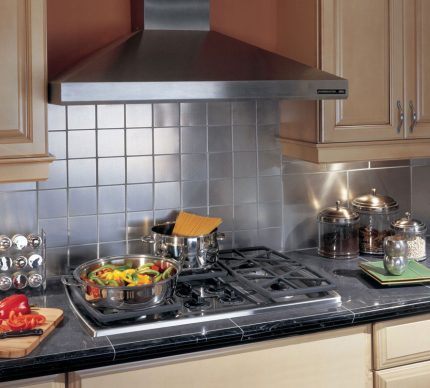
The only drawback of ceramic tile is the complexity of its installation, but we will talk about this a bit below.
Pvc film. It can also be used for wall cladding behind a gas stove. This is a fairly cheap type of polyvinyl chloride coating. The film can be textured and glossy, with a pattern and without. And you can buy it in almost any hardware store.
But, in fact, this is a one-time coating option. After all, this material has extremely low wear resistance. It is more suitable for a temporary solution. For example, when you need to close a more expensive finish.
The best ideas for decorating the wall we reviewed in this photo collection.
Mirror behind the gas stove it looks bright and unusual. It is easy to wash the mirror panel from pollution, it has good resistance to moisture and high temperatures. Such a solution will fit into the interior of almost any kitchen.
Mirror coating also has disadvantages. The main one is the complexity of installation. In addition, in order for the mirror coating to look stylish and aesthetically pleasing, its appearance must be constantly kept clean. Therefore, be prepared for the fact that after each cooking a mirror apron will have to be cleaned from dirt.
Stainless steel, as a finishing material, is also popular. Its surface can be matte, glossy or patterned. Steel has strength, durability, resistance to moisture and temperature extremes.
Such material is quite expensive, therefore, in order not to spoil the coating at the first cleaning, it is worth considering that you need to clean it only with the use of special, non-abrasive cleaners.
Wood behind the gas stove it looks stylish and noble. This is perhaps one of the most environmentally friendly materials for wall decoration. But, before stopping this choice, it is worth considering that such a finish will be very expensive. In addition, for proper installation can not do without the involvement of specialists, and this will also cost a tidy sum.
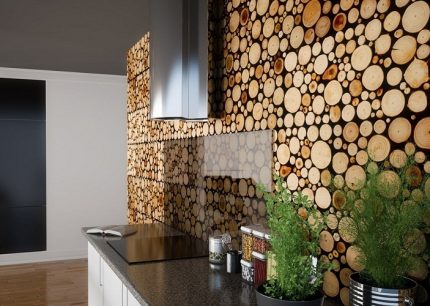
Natural and artificial stone - This group includes a lot of materials and not all of them can be used for wall decoration behind a stove. Among the materials suitable for this purpose, it is worth noting clinker tiles, granite, basalt and porcelain stoneware.
Choosing such materials for finishing a kitchen apron, it is worth considering the high cost of the coating itself and its installation, as well as the fact that if the lining is damaged, it will have to be completely changed, since it can not be repaired.
Traditional methods for decorating a wall behind a stove are listed above, but in addition to them, there are alternative options that you can do with your own hands. More on this in the next photo gallery.
As you can see, there are a lot of options for decorating walls behind gas stoves. You can choose the classic performance, or you can create a masterpiece from improvised materials with your own hands.The decision to make is based on your preferences and financial capabilities.
Wall Instructions
Next, we will discuss a few simple ways how you can independently wall a wall behind a gas stove. What materials and tools will be required for this.
Option number 1 - installation of ceramic tiles
Decorating the working wall in the kitchen with ceramic tiles is one of the most popular and common options. Of course, this work can be entrusted to professionals, or you can try to do it yourself.
But, before proceeding with the decoration of the walls near the gas stove, we recommend that you familiarize yourself with the progress of the upcoming work.
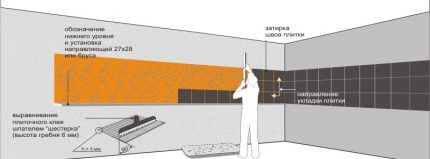
First you need to calculate how much tile is needed for the apron. To do this, measure the height and width of the apron itself, not forgetting to take into account the dimensions and hood location over the gas stove.
The number of tiles will depend on their size and installation method. Given the possible errors in the calculations and the ability to spoil the material, it is better to play it safe and take tiles 10% more of the calculated amount.
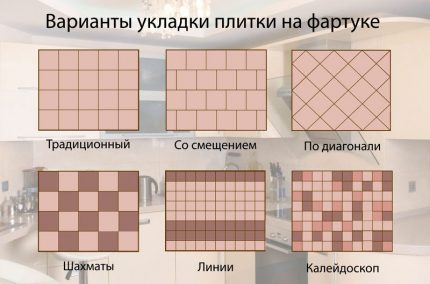
Having bought the required number of tiles, you can begin to prepare tools for work.
For the preparation and wall cladding you will need to use:
- Hammer drill. It may be needed if the walls have an old coating.
- Screwdriver. For stirring the adhesive. Only in advance you need to take care of a special nozzle.
- Bucket. It is better to take a capacious plastic bucket with a volume of at least 10 liters.
- Spatulas. For work you will need a narrow, with a serrated edge and rubber.
- Building level. With its help, the correct laying of the tiles will be monitored.
- Tile cutter. To trim the edges of the tile if necessary.
In addition, it may come in handy: a cord, a ruler and a pencil, a rubber mallet, crosses for mounting tiles, grout and, directly, the adhesive itself.
Having prepared all the necessary tools and materials, you can begin decorating.
After all the tiles have been laid, it remains to wait until the adhesive has dried, then remove the crosses and grout the joints with a rubber spatula.
As you can see, the process itself is not as complicated as it might seem at first glance.
Option number 2 - wall design with a glass screen
A worthy alternative to a ceramic tile shield is the use of special tempered glass. This material will reliably protect the walls of the stove from dirt, it is not exposed to moisture and high temperatures, and also has good wear resistance.
That is why many housewives opt for a glass screen. Yes, and it looks very stylish.
Before starting work, it is necessary to measure the area of the wall on which the glass apron will be mounted.It is better to double-check the accuracy of measurements several times, in order to then avoid installation problems if the product turns out to be slightly larger / smaller than necessary.
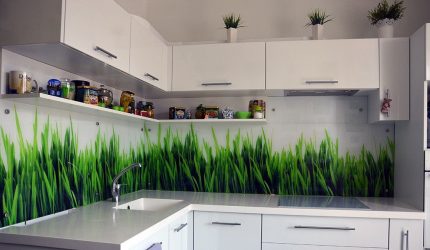
When ordering the manufacture of glass for an apron, you should immediately stipulate making holes for fasteners. They must be at least 5 cm from the corners of the product.
The panels are quite large, so the wall on which they will be mounted must be perfectly flat so that the product fits snugly over the entire area.

Before starting installation, you need to attach the finished apron to the wall and mark with a pencil the location of the fasteners. Then, using a puncher and with a nozzle of the appropriate size, make holes for fasteners, insert dowels and anchors into them.
The next thing to do is to place the glass panel on the anchors and fix it with fixing caps.
As you can see, even a beginner handyman can handle the installation of a glass apron. The main thing here is the accuracy of measurements and smooth walls.
Safety Rules for Material Selection
The most important thing in the design of the kitchen space is the right choice of material for finishing the wall behind the stove, especially if there is gas equipment in the kitchen. In addition to cooking spray, this wall will be exposed to high temperature effects.
Therefore, it is important that there is a heat-resistant material behind the stove. In this regard, ceramic tiles, glass, and metal have worked well.
If the choice fell, for example, on MDF or PVC panels, then you should know that flammable materials cannot be mounted in the immediate vicinity of gas burners, so that such a solution does not turn around fire.

Also, do not forget that next to the gas stove it is extremely undesirable to place a refrigerator. If such a neighborhood is inevitable, then it is worth laying a heat-resistant partition between the devices.
Insulation material is placed between the refrigerator and the stove. Insulation can save refrigeration equipment from overheating, but does not provide protection from fat.
Conclusions and useful video on the topic
The following video will discuss how to independently install a protective screen made of glass:
Installation of ceramic apron:
When choosing a protective screen for the wall behind the gas stove, special attention should be paid to the choice of material. It should have good wear resistance, as it will undergo regular cleaning using detergents. It is also equally important to comply with the installation technology, because even the highest quality material will not last long if the installation technology is not followed.
On the market now you can find material for every taste and budget, so there should be no difficulties with a choice.
Have you ever done the self-installation of an apron behind a gas stove? Please share with our readers what material you chose, and whether you managed to cope with the task. Leave your comments, share experiences, add photos of your kitchens in the discussion block.

 DIY gas stove connection: how to install a gas stove in an apartment step by step
DIY gas stove connection: how to install a gas stove in an apartment step by step 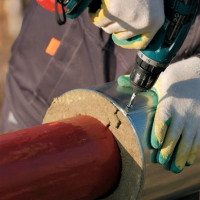 How to insulate a gas pipe on the street from condensation: an overview of the best materials and installation instructions
How to insulate a gas pipe on the street from condensation: an overview of the best materials and installation instructions 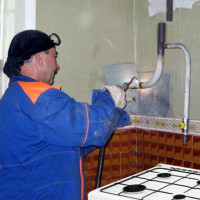 How to transfer a gas pipe in an apartment: transfer rules and location tips
How to transfer a gas pipe in an apartment: transfer rules and location tips  What to do when water gets into the gas pipe: a review of options for resolving the problem and possible consequences
What to do when water gets into the gas pipe: a review of options for resolving the problem and possible consequences 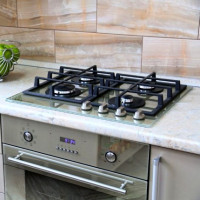 Gas hob connection: safe connection instruction
Gas hob connection: safe connection instruction 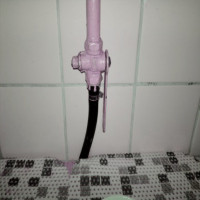 Replacing a gas valve: safety rules, instructions and analysis of popular errors
Replacing a gas valve: safety rules, instructions and analysis of popular errors  How much does it cost to connect gas to a private house: the price of organizing gas supply
How much does it cost to connect gas to a private house: the price of organizing gas supply  The best washing machines with dryer: model rating and customer tips
The best washing machines with dryer: model rating and customer tips  What is the color temperature of light and the nuances of choosing the temperature of the lamps to suit your needs
What is the color temperature of light and the nuances of choosing the temperature of the lamps to suit your needs  Replacement of a geyser in an apartment: replacement paperwork + basic norms and requirements
Replacement of a geyser in an apartment: replacement paperwork + basic norms and requirements